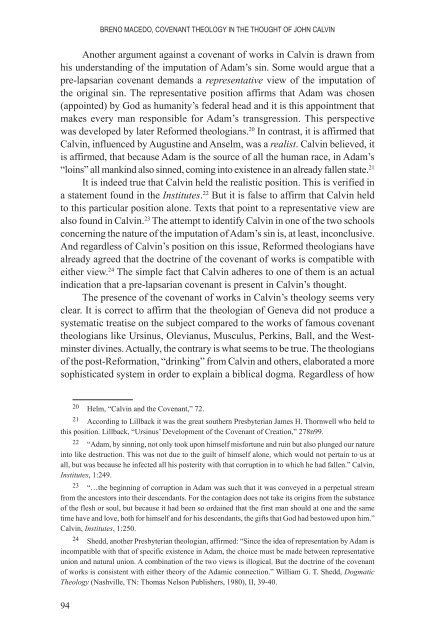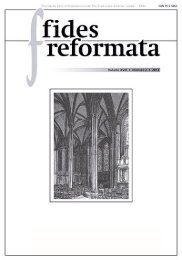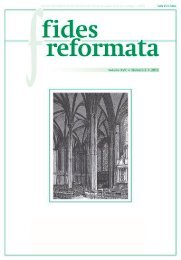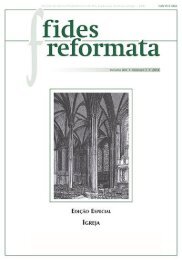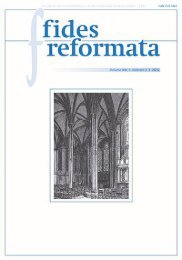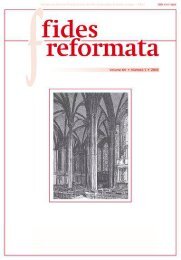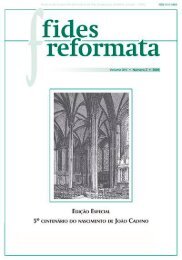Create successful ePaper yourself
Turn your PDF publications into a flip-book with our unique Google optimized e-Paper software.
Breno Mace<strong>do</strong>, Covenant Theology in the Thought of John Calvin<br />
Another argument against a covenant of works in Calvin is drawn from<br />
his understanding of the imputation of Adam’s sin. Some would argue that a<br />
pre-lapsarian covenant demands a representative view of the imputation of<br />
the original sin. The representative position affirms that Adam was chosen<br />
(appointed) by God as humanity’s federal head and it is this appointment that<br />
makes every man responsible for Adam’s transgression. This perspective<br />
was developed by later Reformed theologians. <strong>20</strong> In contrast, it is affirmed that<br />
Calvin, influenced by Augustine and Anselm, was a realist. Calvin believed, it<br />
is affirmed, that because Adam is the source of all the human race, in Adam’s<br />
“loins” all mankind also sinned, coming into existence in an already fallen state. 21<br />
It is indeed true that Calvin held the realistic position. This is verified in<br />
a statement found in the Institutes. 22 But it is false to affirm that Calvin held<br />
to this particular position alone. Texts that point to a representative view are<br />
also found in Calvin. 23 The attempt to identify Calvin in one of the two schools<br />
concerning the nature of the imputation of Adam’s sin is, at least, inconclusive.<br />
And regardless of Calvin’s position on this issue, Reformed theologians have<br />
already agreed that the <strong>do</strong>ctrine of the covenant of works is compatible with<br />
either view. 24 The simple fact that Calvin adheres to one of them is an actual<br />
indication that a pre-lapsarian covenant is present in Calvin’s thought.<br />
The presence of the covenant of works in Calvin’s theology seems very<br />
clear. It is correct to affirm that the theologian of Geneva did not produce a<br />
systematic treatise on the subject compared to the works of famous covenant<br />
theologians like Ursinus, Olevianus, Musculus, Perkins, Ball, and the Westminster<br />
divines. Actually, the contrary is what seems to be true. The theologians<br />
of the post-Reformation, “drinking” from Calvin and others, elaborated a more<br />
sophisticated system in order to explain a biblical <strong>do</strong>gma. Regardless of how<br />
<strong>20</strong> Helm, “Calvin and the Covenant,” 72.<br />
21 According to Lillback it was the great southern Presbyterian James H. Thornwell who held to<br />
this position. Lillback, “Ursinus’ Development of the Covenant of Creation,” 278n99.<br />
22 “Adam, by sinning, not only took upon himself misfortune and ruin but also plunged our nature<br />
into like destruction. This was not due to the guilt of himself alone, which would not pertain to us at<br />
all, but was because he infected all his posterity with that corruption in to which he had fallen.” Calvin,<br />
Institutes, 1:249.<br />
23 “…the beginning of corruption in Adam was such that it was conveyed in a perpetual stream<br />
from the ancestors into their descendants. For the contagion <strong>do</strong>es not take its origins from the substance<br />
of the flesh or soul, but because it had been so ordained that the first man should at one and the same<br />
time have and love, both for himself and for his descendants, the gifts that God had bestowed upon him.”<br />
Calvin, Institutes, 1:250.<br />
24 Shedd, another Presbyterian theologian, affirmed: “Since the idea of representation by Adam is<br />
incompatible with that of specific existence in Adam, the choice must be made between representative<br />
union and natural union. A combination of the two views is illogical. But the <strong>do</strong>ctrine of the covenant<br />
of works is consistent with either theory of the Adamic connection.” William G. T. Shedd, Dogmatic<br />
Theology (Nashville, TN: Thomas Nelson Publishers, 1980), II, 39-40.<br />
94


